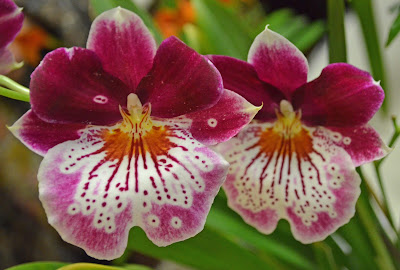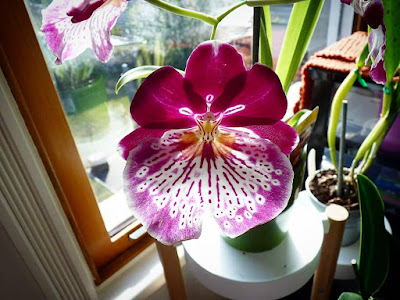Miltoniopsis Breathless is a cross between Miltoniopsis Pink Lady and Miltoniopsis Pearl Ono. The species ancestors of this hybrid are: Miltoniopsis vexillaria, Miltoniopsis roezlii, Miltoniopsis phalaenopsis.
Miltoniopsis Breathless also called as Pansy orchid 'Breathless', is a hybrid in the genus Miltoniopsis. This hybrid was registered by Okika in 2005 (RHS).
IDENTIFY MILTONIOPSIS BREATHLESS ORCHID PLANT
Miltoniopsis Breathless is a cross between Miltoniopsis Pink Lady and Miltoniopsis Pearl Ono. The species ancestors of this hybrid are: Miltoniopsis vexillaria, Miltoniopsis roezlii, Miltoniopsis phalaenopsis.
It is an epiphyte with slightly flattened pseudobulbs which grow quite tightly that carry the leaves which are excellent indicators of the state of plants. Some common clones of this hybrid: Miltoniopsis Breathless 'Beauty' with red petals and a lip that is streaked in red, white and pink; Miltoniopsis Breathless 'Florence' with red petals, with a white waterfall lip, blending into a yellow center; Miltoniopsis Breathless ‘Brilliant’, a velvety deep red with a spectacular, white lip with red waterfall pattern.
MILTONIOPSIS BREATHLESS ORCHID PLANT CARE AND CULTURE
Cultural information should only be used as a guide, and should be to be adapted to suit you. Your physical location; where you grow your plants, how much time you have to devote to their care, and many other factors, will need to be taken into account. Only then can you decide on the cultural methods that best suit you and your plants.
Light:
Miltoniopsis Breathless needs a light level of 10000-20000 lux. This hybrid creates the most flowers when it receives as much light as it can tolerate without damaging the leaves. The slightly pinkish color of the leaves indicates the optimal dose of light, while red, yellow or straw-colored leaves indicate too much light.
Temperature:
The average temperature of the day should be 27-29 ° C, the night 16-18 ° C, and the daily amplitude 11 ° C. Plants can tolerate temperatures of up to more than 32 ° C for a short period of time, providing high humidity and strong air movement.
Humidity:
Humidity during the day should be on average 70-80%, reaching at night a maximum of 80-90%, and in the afternoon a minimum of 50-60%. If high humidity in the winter creates problems with condensation, it can be slightly lowered. The strong air movement, however, prevents condensation, even when the humidity is high.
Substrate, growing media and repotting:
Miltoniopsis Breathless are usually grown in plastic pots because it is easier to keep moisture, but excellent drainage must be ensured. A layer of thick bark on the bottom of the pot improves the outflow of water. To improve it, you can also enlarge the holes in the pot, and even make additional ones by burning them with a suitable tool or cut-out. The fumes of melted plastic can be poisonous, so this should be done in the open or with good ventilation. The substrate must ensure adequate drainage of excess water. Many people use a small bark mixed with moisture-retaining materials, such as perlite or cut sphagnum moss. Some also use charcoal as additives, crushed oyster shells, peanut shells, thick peat, or chopped tree fern fiber. These additives vary depending on the experience of watering and general growing conditions.
This hybrid like annual replanting. In addition to complying with the basic requirements, annual replanting is the most important activity that can ensure success in cultivation. Do not overdo it to large pots! Plants should be planted into small pots, providing space for increments of only one year. When transplanting these plants is not about translating the plant into a larger pot with the entire old, compact body of the substrate. The entire medium should be removed, all damaged or diseased roots cut off, and the plant placed in fresh medium and clean pot. It is best to perform transplanting in the autumn when new roots begin to grow, and the new growth reaches half of the mature. Plant replanting at the beginning of winter will give her time to rush before the onset of hot summer days.
Watering:
2-3 times watering weekly, from spring to autumn. The substrate of this hybrid should always be kept moist. Do not let them dry up completely. During hot, dry summers, the plants may require daily watering. However, during winters, the plants can only be watered once every 2-3 weeks. The only time when the plants should be somewhat dried up is the period just after transplanting, especially if it was replanted before the growth period of new roots. Regular watering resumes immediately after emergence of new roots in fresh soil.
Fertilizer:
During the active growth, the plant should be fertilized every week 1/4-1/2 of the recommended dose of fertilizer for orchids. Most prefer the use of nitrogen-enriched fertilizers, e.g. 30-10-10, for almost a whole year. Instead, they recommend the use of a fertilizer with less nitrogen, and higher phosphorus, e.g. 10-20-10, every 3-4 weeks. Periodic application of a fertilizer with an increased amount of phosphorus improves flowering. It is necessary to rinse the substrate every few weeks to prevent accumulation of salt, especially when using high doses of fertilizers.
Rest period:
Miltoniopsis Breathless do not need a rest period. The growing conditions should be maintained throughout the year. It is important to maintain a daily temperature difference of 6-11 ° C. In winter, watering should be somewhat restricted, especially for plants grown in dark, short days at moderate latitudes, or when the temperature drops below 16 ° C at night. Just in a situation where there is less light, the day is short and the temperatures lower, the plants consume less water. However, do not allow them to completely dry up. If the amount of water supplied decreases, the fertilization should also be reduced until new increments are created in spring.















COMMENTS